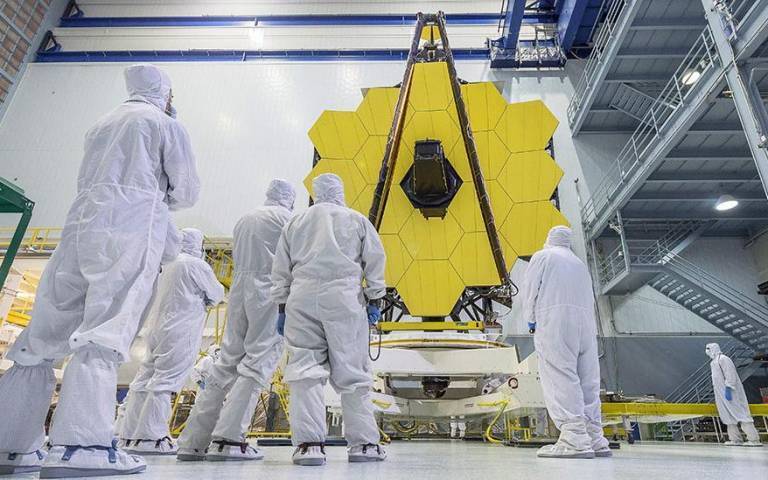New space telescope to uncover secrets of Universe’s origins
20 December 2021
The NASA-led James Webb Space Telescope, which includes hardware designed and built at UCL and which will image the very first stars to shine in the Universe, is scheduled to be launched into space later this month.

The telescope, one of the great space observatories following Hubble, will be launched on-board the Ariane rocket from Europe’s spaceport in French Guiana on or after Friday 24 December. It will take 30 days for the telescope to reach the Lagrange point 2, about a million miles from Earth, where it will begin operating. UCL astronomers will be among the first to analyse its observations of the Universe.
The mission – a partnership between NASA, the European Space Agency (ESA) and the Canadian Space Agency (CSA) – is expected to make breakthrough discoveries in all fields of astronomy by investigating the light of the Universe at (invisible) infrared wavelengths.
A team at the UCL Mullard Space Science Laboratory designed and built a key piece of hardware for one of the telescope’s four instruments, a near-infrared spectrometer called the NIRSpec. About the size of a double bed, the NIRSpec measures light split into different wavelengths.
The UCL-built component, called the Calibration Source, consists of 11 mini-telescopes projecting light into a sphere, the output of which produces an even illumination of the NIRSpec detectors. This reference illumination reveals the sensitivity and arrangement of every part of NIRSpec’s optics and detectors to different wavelengths of light, allowing astronomers to more precisely measure the properties of light emitted by planets, stars and galaxies.
The final work to design and build the component took place between 2005 and 2010. UCL scientists and engineers, supported by researchers at Durham University, also built a larger replica of the unit together with other equipment so that NIRSpec could be rigorously tested on Earth at minus 30 degrees.
Prof. Mike Barlow (Astrophysics) is a member of the European Science Team for James Webb’s mid-infrared imager (MIRI), which involves advising the instrument team and planning how to use 450 hours of MIRI’s observation time. He is co-leading a programme of observations of the remnant of Supernova 1987A, one of the brightest exploding stars astronomers have ever seen.
Our very own Prof. Richard Ellis and Dr Aayush Saxena will be analysing the first cycles of observations from James Webb to probe the evolution of the first stars, galaxies and black holes.
Astronomers Dr Andrew Swan and Prof. Jay Farihi have secured time on James Webb for studying a rare example of white dwarf hosting a planetary debris disk.
Image: The James Webb Space Telescope. Credit: NASA.
 Close
Close

